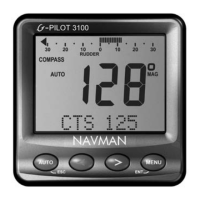
Do you have a question about the Navman G-PILOT 3100 and is the answer not in the manual?
| Type | Autopilot System |
|---|---|
| Model | G-PILOT 3100 |
| Manufacturer | Navman |
| Communication Protocol | NMEA 0183 |
| Rudder Feedback | Yes |
| Waypoint Navigation | Yes |
| Track Following | Yes |
| Power Supply | 12V DC |
| Display | LCD |
Diagram illustrating the typical connection of G-PILOT 3100 components and optional instruments.
Instructions for powering the G-PILOT 3100 unit on and off, noting settings are retained.
Explanation of the four keys (AUTO, ESC, <, >) and their functions, including press and hold actions.
Guidance on starting the G-PILOT 3100, including initial setup and basic usage steps.
Details on selecting between Compass, GPS, and Wind steering modes for power and sailing boats.
Overview of the three operational states: Standby, Auto, and Hand Steer, and how to switch between them.
Instructions for manually steering the rudder using the < and > keys when in STBY mode.
How to set the screen and key backlight brightness levels from OFF to 4 (most bright).
Information on how the main display shows boat heading and options for displaying True or Magnetic heading.
Configuration of the bar data display to show rudder angle or course error.
Selection of steering or navigation data to be displayed in the info data section.
How alarms are indicated, how to mute/cancel them, and types of alarms including low battery.
Instructions for activating simulate mode to practice operation without being on the water.
Guide to accessing and changing menu data, including MAIN, CONFIG, ALARMS, OPTIONS, VESSEL, and DEVICES menus.
A flowchart illustrating key combinations for various functions like power, steering modes, and dodges.
Explanation of data displayed in Compass mode: Boat heading, course error, and course to steer (CTS).
Steps to activate AUTO or HAND STEER modes and to disengage the G-PILOT in compass mode.
Procedure for changing the set course (CTS) in 1° and 10° steps.
How to execute a sharp course change (dodge) to port or starboard to avoid obstacles.
Instructions for initiating an auto tack for sailing boats, including tack delay and angle settings.
Details of navigation data displayed in GPS mode, such as BRG, CTS, DTG, SOG, TTG, and XTE.
Steps to engage AUTO or HAND STEER in GPS mode and disengage the unit.
Procedure for performing a dodge maneuver to avoid obstacles while navigating via GPS.
Explanation of data relevant to wind steering: Boat heading, course error, CTS, SWA, APP, and TRUE wind angles.
How to engage AUTO or HAND STEER for wind-based steering and disengage the unit.
Procedure for adjusting the desired wind angle (SWA) in 1° and 10° steps for optimal sailing.
Instructions for executing a dodge maneuver to avoid obstacles while steering by wind angle.
How to initiate auto tacking or gybing based on set wind angle, including tack/gybe delay.
Description of six adjustable parameters (Response, Ratio, Gains) for fine-tuning steering performance.
Explanation of using stored profiles (1-5) to quickly set steering parameters for different conditions.
Guide to diagnosing and resolving common steering issues by adjusting specific parameters.
Technical specifications for power supply, current draw, and interface connections (NavBus, NMEA).
Details on terminal block and connector pinouts for the main unit, including power and signal lines.
Information on the wiring and color coding for the display unit's power and data cable.
Comprehensive list of G-PILOT 3100 alarms, their reasons, and recommended user actions.
Key to the notes (a, c, m, s) used to describe alarm behavior and system changes.
Troubleshooting steps for power-on failures, frequent course corrections, and drifting.
Guidance for resolving display fogging and unexpected values or simulation mode activation.
Contact details for Navman offices and distributors worldwide, organized by region.